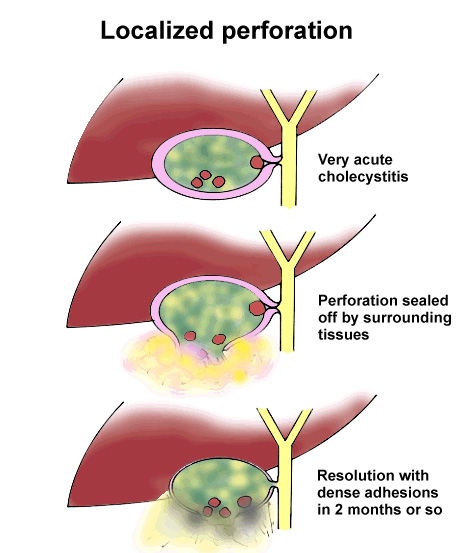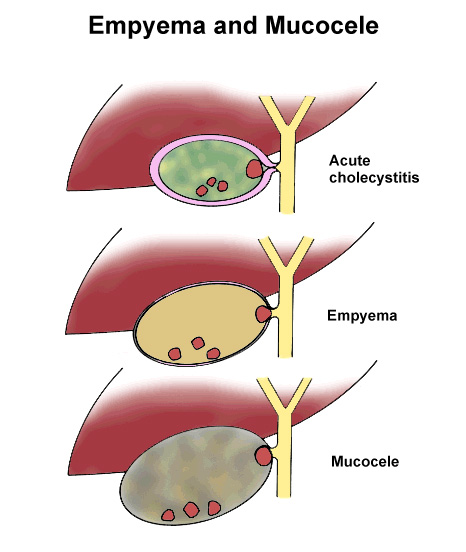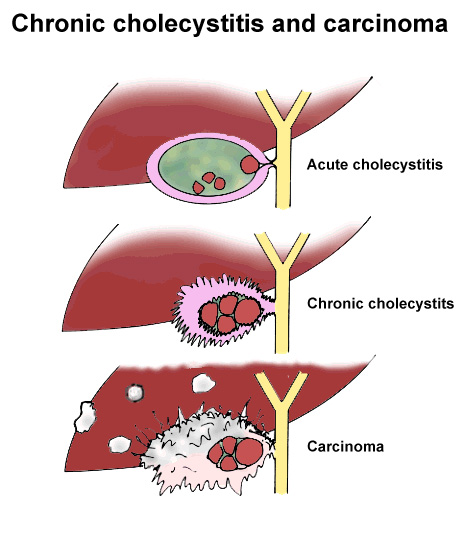Gallstone disease natural history, complications and prognosis: Difference between revisions
| Line 40: | Line 40: | ||
===Symptomatic stones=== | ===Symptomatic stones=== | ||
Occasionally, gallstones | Occasionally, gallstones can be symptomatic and this manifests as pain in the right upper quadrant, known as biliary colic, accompanied by nausea, vomiting and diarrhea. The patients whom experience an episode of pain recurrence ([[Gallstone disease history and symptoms|biliary colic]]) once per year are around 38-50%.<ref name="pmid20492328">{{cite journal |vauthors=Festi D, Reggiani ML, Attili AF, Loria P, Pazzi P, Scaioli E, Capodicasa S, Romano F, Roda E, Colecchia A |title=Natural history of gallstone disease: Expectant management or active treatment? Results from a population-based cohort study |journal=J. Gastroenterol. Hepatol. |volume=25 |issue=4 |pages=719–24 |year=2010 |pmid=20492328 |doi=10.1111/j.1440-1746.2009.06146.x |url=}}</ref> | ||
===Prognosis=== | ===Prognosis=== | ||
*The [[prognosis]] in patients with Gallstone disease is dependent upon the occurence and severity of complications. The category of patients whom refuse or are unfit for surgery will remain asymptomatic 45% of the time, whilst 55% will have varying degrees of complications.<ref name="pmid26895902">{{cite journal |vauthors=Julliard O, Hauters P, Possoz J, Malvaux P, Landenne J, Gherardi D |title=Incisional hernia after single-incision laparoscopic cholecystectomy: incidence and predictive factors |journal=Surg Endosc |volume=30 |issue=10 |pages=4539–43 |year=2016 |pmid=26895902 |doi=10.1007/s00464-016-4790-4 |url=}}</ref> | *The [[prognosis]] in patients with Gallstone disease is dependent upon the occurence and severity of complications. The category of patients whom refuse or are unfit for surgery will remain asymptomatic 45% of the time, whilst 55% will have varying degrees of complications.<ref name="pmid26895902">{{cite journal |vauthors=Julliard O, Hauters P, Possoz J, Malvaux P, Landenne J, Gherardi D |title=Incisional hernia after single-incision laparoscopic cholecystectomy: incidence and predictive factors |journal=Surg Endosc |volume=30 |issue=10 |pages=4539–43 |year=2016 |pmid=26895902 |doi=10.1007/s00464-016-4790-4 |url=}}</ref> | ||
==References== | ==References== | ||
Revision as of 16:32, 29 November 2017
|
Gallstone disease Microchapters |
|
Diagnosis |
|---|
|
Treatment |
|
Surgery |
|
Case Studies |
|
Gallstone disease natural history, complications and prognosis On the Web |
|
American Roentgen Ray Society Images of Gallstone disease natural history, complications and prognosis |
|
FDA on Gallstone disease natural history, complications and prognosis |
|
CDC on Gallstone disease natural history, complications and prognosis |
|
Gallstone disease natural history, complications and prognosis in the news |
|
Blogs on Gallstone disease natural history, complications and prognosis |
|
Risk calculators and risk factors for Gallstone disease natural history, complications and prognosis |
Editor-In-Chief: C. Michael Gibson, M.S., M.D. [1]; Associate Editor(s)-in-Chief: Hadeel Maksoud M.D.[2]
Overview
Gallstones develop in many people without causing symptoms. The chance of symptoms or complications from gallstones is about 20%. Nearly all patients (99%) who have gallbladder surgery do not have their symptoms return.[1]
Natural History, Complications, and Prognosis
Natural History
- Gallstone disease is typically asymptomatic. 16-26% of patients develop gallstone-related symptoms in 10 years. Prophylactic cholecystectomy is not indicated unless symptoms develop or there is an increased risk of gallbladder cancer:[1]
- Pima Indian
- Calcified gallbladder
- Gallbladder polyp >10 mm
- Gallstones >2.5 cm
- Salmonella carrier
Complications
- Common complications of gallbladder disease include:
- Obstructive jaundice
- Acute cholecystitis
- Choledocholithiasis with or without acute cholangitis
- Gallstone pancreatitis
- Gallstone Ileus[2]
Diagrams shown below:
Source:medicalassessmentonline[3]
Symptomatic stones
Occasionally, gallstones can be symptomatic and this manifests as pain in the right upper quadrant, known as biliary colic, accompanied by nausea, vomiting and diarrhea. The patients whom experience an episode of pain recurrence (biliary colic) once per year are around 38-50%.[4]
Prognosis
- The prognosis in patients with Gallstone disease is dependent upon the occurence and severity of complications. The category of patients whom refuse or are unfit for surgery will remain asymptomatic 45% of the time, whilst 55% will have varying degrees of complications.[5]
References
- ↑ 1.0 1.1 Gracie WA, Ransohoff DF (1982). "The natural history of silent gallstones: the innocent gallstone is not a myth". N. Engl. J. Med. 307 (13): 798–800. doi:10.1056/NEJM198209233071305. PMID 7110244.
- ↑ Friedman GD (1993). "Natural history of asymptomatic and symptomatic gallstones". Am. J. Surg. 165 (4): 399–404. PMID 8480871.
- ↑ "Gallbladder disease".
- ↑ Festi D, Reggiani ML, Attili AF, Loria P, Pazzi P, Scaioli E, Capodicasa S, Romano F, Roda E, Colecchia A (2010). "Natural history of gallstone disease: Expectant management or active treatment? Results from a population-based cohort study". J. Gastroenterol. Hepatol. 25 (4): 719–24. doi:10.1111/j.1440-1746.2009.06146.x. PMID 20492328.
- ↑ Julliard O, Hauters P, Possoz J, Malvaux P, Landenne J, Gherardi D (2016). "Incisional hernia after single-incision laparoscopic cholecystectomy: incidence and predictive factors". Surg Endosc. 30 (10): 4539–43. doi:10.1007/s00464-016-4790-4. PMID 26895902.






